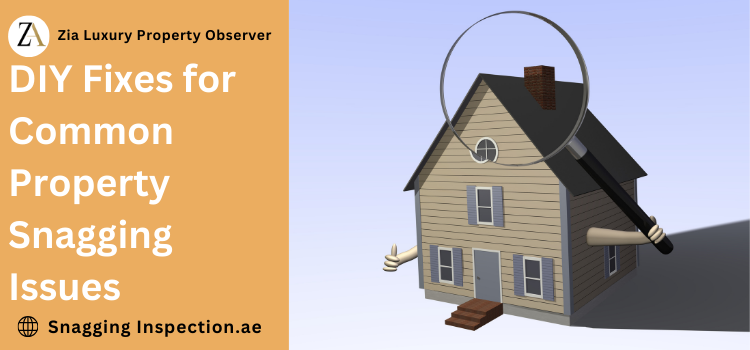When you move into a new property, it’s normal to find some small problems or “snags” that need fixing. These could be cracks in the walls, leaky faucets, or loose door handles. While some issues may need a professional’s help, many can be fixed with simple DIY solutions. We’ll walk you through 10 common snagging issues that you can easily handle yourself. We’ll provide detailed steps for each fix, so you can get your new home looking and functioning perfectly. If you’re unsure about larger problems, remember that professional property inspections can catch anything you might miss. Read on to learn how to tackle these common problems and make your home feel just right!
10 Simple DIY Fixes for Common Property Snagging Issues
Let’s explore ten common snagging problems you might encounter and provide simple, step-by-step DIY solutions for each. With these practical tips, you can quickly improve your living space and make your property feel like home.
1. Fixing Uneven Surfaces and Walls
Uneven walls and surfaces are a frequent snagging issue. These can result from substandard plastering or poor quality materials. To address this, use a wall filler to even out imperfections. Follow up with sanding to smoothen the surface. A coat of primer and paint will give your walls a uniform finish. This simple DIY can save you the cost of hiring a professional.
2. Sealing Window Gaps for Better Insulation
Windows often have gaps that cause drafts and energy inefficiency. Use weatherstripping tape or sealant to fill in gaps and cracks around windows. For larger gaps, expanding foam sealant is a good option. Not only does this DIY solution improve insulation, but it also reduces noise and keeps pests out.
3. Repairing Loose Door Handles
Loose door handles are an annoyance and a common snagging issue. Tighten the screws holding the handle in place with a screwdriver. If the screw holes are stripped, fill them with wooden toothpicks dipped in wood glue, let them dry, and then reinsert the screws for a more secure fit. This quick fix ensures smooth functionality of your doors.
Pro Tip
Before diving into repairs, create a snagging checklist to stay organized. Walk through each room, noting any issues such as cracks, leaks, or uneven surfaces. This list will help you prioritize repairs and ensure nothing is overlooked.
Download Free Property Inspection Report Template
4. Fixing Leaky Faucets
A dripping faucet can significantly increase your water bill. For this issue, first, turn off the water supply. Remove the faucet handle, replace the old washer with a new one, and reassemble the faucet. Most leaky faucets are caused by worn-out washers or O-rings, and replacing them is a straightforward DIY fix.
5. Repairing Cracked Tiles
Cracked tiles in the bathroom or kitchen can ruin the look of the space and become a safety hazard. To fix this, start by removing the broken tile pieces. Apply tile adhesive to the floor and place a new tile into position. Once it’s set, fill the grout lines with grout sealer. This fix keeps the floor intact and prevents further cracking.
6. Re-Caulking Gaps in the Bathroom
Old caulking in bathrooms can deteriorate, leading to leaks and mold growth. Remove the old caulk using a utility knife or scraper, then clean the area. Apply a new bead of waterproof caulk to the gaps around the bathtub, sink, or shower area. Smoothing it with a caulk finishing tool ensures a neat and watertight seal.
Book your Inspection with us today.
Our expert team is ready to conduct a thorough assessment of your property, identifying any potential issues and providing you with actionable recommendations.
7. Fixing Squeaky Floors
Squeaky floors are common in new properties. They usually result from floorboards rubbing against each other. To fix this, sprinkle talcum powder between the floorboards to reduce friction. If the problem persists, you can screw the loose boards down using wood screws. These simple steps make the floors quieter and more stable.
8. Adjusting Misaligned Cabinet Doors
Misaligned cabinet doors can affect the aesthetic appeal of your kitchen or bathroom. Using a screwdriver, adjust the screws on the hinges to align the doors properly. You may need to tighten or loosen the screws to make the door sit flush. This minor adjustment can have a big impact on the overall look of your cabinets.
9. Replacing Faulty Light Switches
A faulty light switch can be a potential safety hazard. Before attempting this fix, turn off the power at the circuit breaker. Remove the switch cover plate and replace the old switch with a new one, connecting the wires securely. Reattach the cover plate and turn the power back on. Always ensure safety measures when dealing with electrical repairs.
10. Unclogging Slow Drains
A slow-draining sink or shower is another common snagging issue. First, pour boiling water down the drain. If the clog persists, use a mixture of baking soda and vinegar, followed by more hot water. For stubborn blockages, a drain snake can be used to clear the pipe. Regular maintenance will keep your drains flowing freely.
By addressing these common snagging issues, you can maintain your property’s value and live comfortably. For more complex problems, professional inspection services like ours can provide peace of mind.
Conclusion
Fixing common snagging issues in your new property doesn’t always have to be a stressful or costly process. With a little effort and the right tools, you can handle many of these problems on your own. From sealing window gaps to fixing leaky faucets, these DIY solutions can help keep your home in top shape. However, some issues may require a professional touch to ensure everything is safe and up to standard. If you come across a snag that seems too complicated or if you want a thorough inspection, consider getting professional help.


